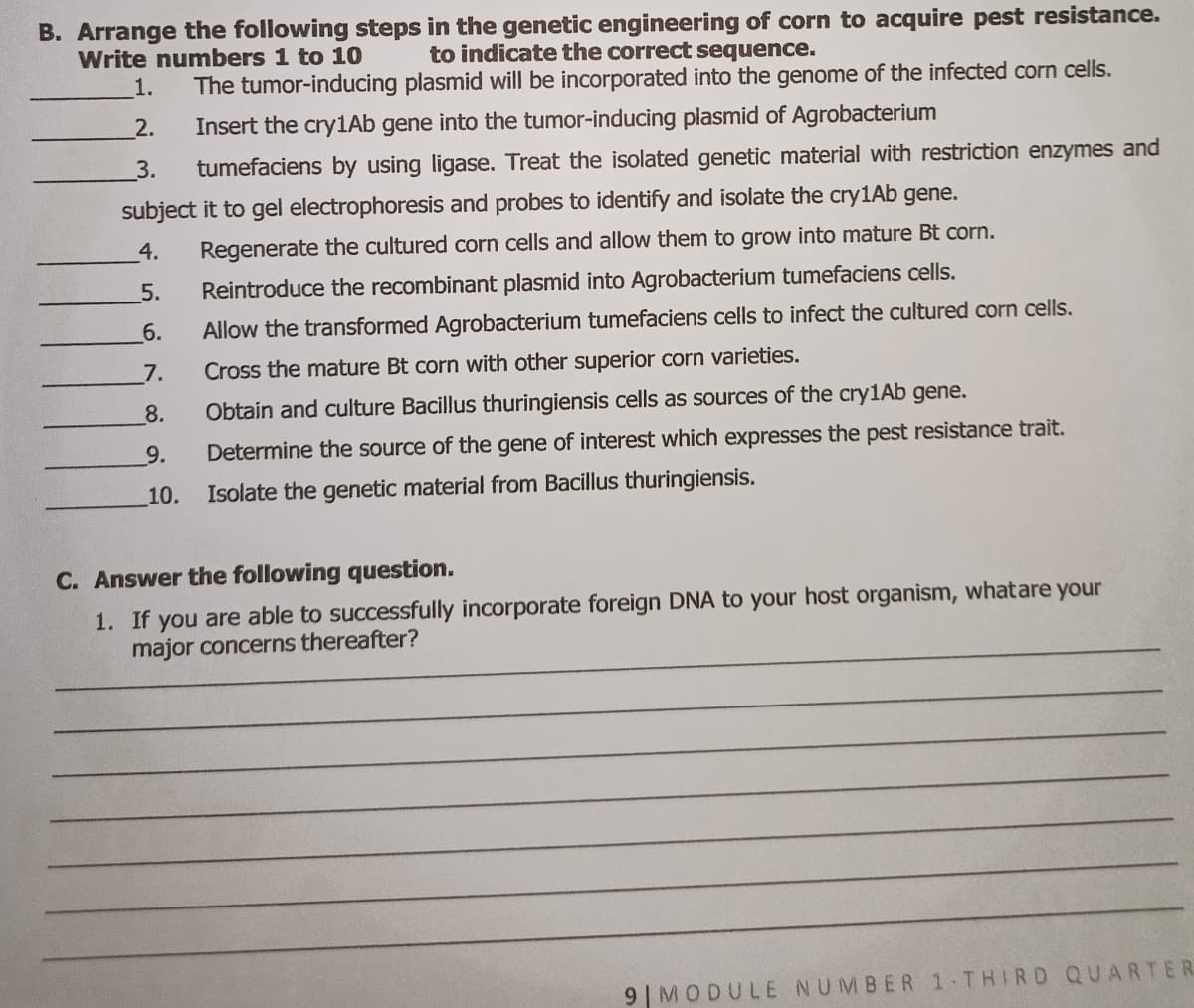B. Arrange the following steps in the genetic engineering of corn to acquire pest resistance. to indicate the correct sequence. The tumor-inducing plasmid will be incorporated into the genome of the infected corn cells. Write numbers 1 to 1O 1. 2. Insert the cry1Ab gene into the tumor-inducing plasmid of Agrobacterium 3. tumefaciens by using ligase. Treat the isolated genetic material with restriction enzymes and subject it to gel electrophoresis and probes to identify and isolate the cry1Ab gene. 4. Regenerate the cultured corn cells and allow them to grow into mature Bt corn. 5. Reintroduce the recombinant plasmid into Agrobacterium tumefaciens cells. 6. Allow the transformed Agrobacterium tumefaciens cells to infect the cultured corn cells. 7. Cross the mature Bt corn with other superior corn varieties. 8. Obtain and culture Bacillus thuringiensis cells as sources of the cry1Ab gene. 9. Determine the source of the gene of interest which expresses the pest resistance trait. 10. Isolate the genetic material from Bacillus thuringiensis. C. Answer the following question. 1. If you are able to successfully incorporate foreign DNA to your host organism, whatare your major concerns thereafter? 9 | MODULE NUMBER 1 THIRD QUARTER
B. Arrange the following steps in the genetic engineering of corn to acquire pest resistance. to indicate the correct sequence. The tumor-inducing plasmid will be incorporated into the genome of the infected corn cells. Write numbers 1 to 1O 1. 2. Insert the cry1Ab gene into the tumor-inducing plasmid of Agrobacterium 3. tumefaciens by using ligase. Treat the isolated genetic material with restriction enzymes and subject it to gel electrophoresis and probes to identify and isolate the cry1Ab gene. 4. Regenerate the cultured corn cells and allow them to grow into mature Bt corn. 5. Reintroduce the recombinant plasmid into Agrobacterium tumefaciens cells. 6. Allow the transformed Agrobacterium tumefaciens cells to infect the cultured corn cells. 7. Cross the mature Bt corn with other superior corn varieties. 8. Obtain and culture Bacillus thuringiensis cells as sources of the cry1Ab gene. 9. Determine the source of the gene of interest which expresses the pest resistance trait. 10. Isolate the genetic material from Bacillus thuringiensis. C. Answer the following question. 1. If you are able to successfully incorporate foreign DNA to your host organism, whatare your major concerns thereafter? 9 | MODULE NUMBER 1 THIRD QUARTER
Human Anatomy & Physiology (11th Edition)
11th Edition
ISBN:9780134580999
Author:Elaine N. Marieb, Katja N. Hoehn
Publisher:Elaine N. Marieb, Katja N. Hoehn
Chapter1: The Human Body: An Orientation
Section: Chapter Questions
Problem 1RQ: The correct sequence of levels forming the structural hierarchy is A. (a) organ, organ system,...
Related questions
Question
100%
General Biology -
B. Arrange the following
C. Answer the question
You can read each instructions for clarification, thanks!

Transcribed Image Text:B. Arrange the following steps in the genetic engineering of corn to acquire pest resistance.
to indicate the correct sequence.
The tumor-inducing plasmid will be incorporated into the genome of the infected corn cells.
Write numbers 1 to 1O
1.
2.
Insert the cry1Ab gene into the tumor-inducing plasmid of Agrobacterium
3.
tumefaciens by using ligase. Treat the isolated genetic material with restriction enzymes and
subject it to gel electrophoresis and probes to identify and isolate the cry1Ab gene.
4.
Regenerate the cultured corn cells and allow them to grow into mature Bt corn.
5.
Reintroduce the recombinant plasmid into Agrobacterium tumefaciens cells.
6.
Allow the transformed Agrobacterium tumefaciens cells to infect the cultured corn cells.
7.
Cross the mature Bt corn with other superior corn varieties.
8.
Obtain and culture Bacillus thuringiensis cells as sources of the cry1Ab gene.
9.
Determine the source of the gene of interest which expresses the pest resistance trait.
10. Isolate the genetic material from Bacillus thuringiensis.
C. Answer the following question.
1. If you are able to successfully incorporate foreign DNA to your host organism, whatare your
major concerns thereafter?
9 | MODULE NUMBER 1 THIRD QUARTER
Expert Solution
This question has been solved!
Explore an expertly crafted, step-by-step solution for a thorough understanding of key concepts.
This is a popular solution!
Trending now
This is a popular solution!
Step by step
Solved in 2 steps

Knowledge Booster
Learn more about
Need a deep-dive on the concept behind this application? Look no further. Learn more about this topic, biology and related others by exploring similar questions and additional content below.Recommended textbooks for you

Human Anatomy & Physiology (11th Edition)
Biology
ISBN:
9780134580999
Author:
Elaine N. Marieb, Katja N. Hoehn
Publisher:
PEARSON

Biology 2e
Biology
ISBN:
9781947172517
Author:
Matthew Douglas, Jung Choi, Mary Ann Clark
Publisher:
OpenStax

Anatomy & Physiology
Biology
ISBN:
9781259398629
Author:
McKinley, Michael P., O'loughlin, Valerie Dean, Bidle, Theresa Stouter
Publisher:
Mcgraw Hill Education,

Human Anatomy & Physiology (11th Edition)
Biology
ISBN:
9780134580999
Author:
Elaine N. Marieb, Katja N. Hoehn
Publisher:
PEARSON

Biology 2e
Biology
ISBN:
9781947172517
Author:
Matthew Douglas, Jung Choi, Mary Ann Clark
Publisher:
OpenStax

Anatomy & Physiology
Biology
ISBN:
9781259398629
Author:
McKinley, Michael P., O'loughlin, Valerie Dean, Bidle, Theresa Stouter
Publisher:
Mcgraw Hill Education,

Molecular Biology of the Cell (Sixth Edition)
Biology
ISBN:
9780815344322
Author:
Bruce Alberts, Alexander D. Johnson, Julian Lewis, David Morgan, Martin Raff, Keith Roberts, Peter Walter
Publisher:
W. W. Norton & Company

Laboratory Manual For Human Anatomy & Physiology
Biology
ISBN:
9781260159363
Author:
Martin, Terry R., Prentice-craver, Cynthia
Publisher:
McGraw-Hill Publishing Co.

Inquiry Into Life (16th Edition)
Biology
ISBN:
9781260231700
Author:
Sylvia S. Mader, Michael Windelspecht
Publisher:
McGraw Hill Education